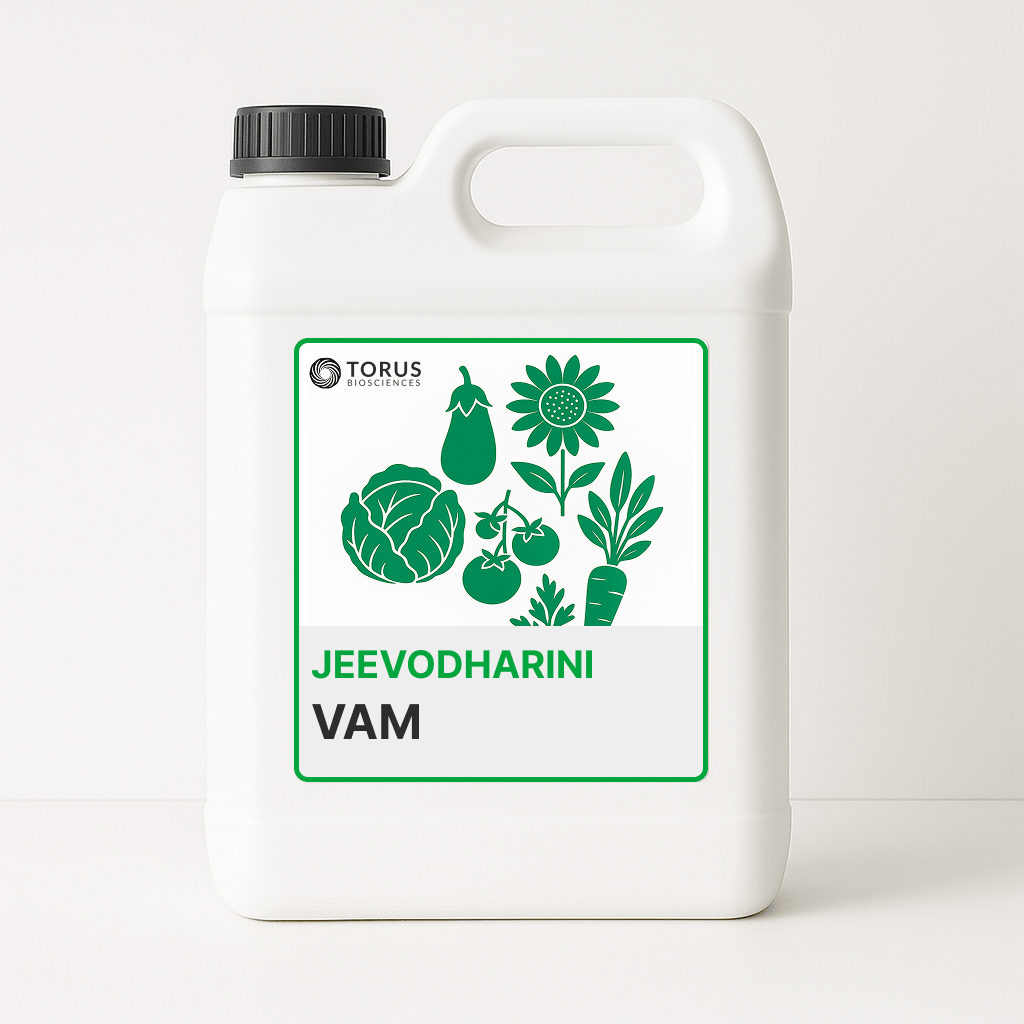
VAM
A beneficial fungus that forms a symbiotic relationship with plant roots, helping them access nutrients and water from a larger soil volume.

Vesicular Arbuscular Mycorrhizae (VAM) are specialized soil fungi that form symbiotic relationships with approximately 80% of terrestrial plant species. Unlike conventional biofertilizers, VAM creates a living extension of the plant’s root system through microscopic fungal hyphae that explore soil volumes inaccessible to roots alone, dramatically enhancing nutrient and water acquisition.
Extensive research demonstrates that VAM colonization significantly improves plant growth, yield, and stress tolerance across diverse agricultural systems, functioning as both a biofertilizer and bioprotectant through multiple direct and indirect mechanisms.
Benefits
-
Enhanced Phosphorus Acquisition: VAM fungi dramatically improve phosphorus nutrition, increasing uptake by 30-50% through multiple mechanisms. The microscopic hyphae (2-5 μm diameter) access soil phosphorus beyond the depletion zone around roots, while specialized phosphatase enzymes release phosphorus from organic compounds. This improved phosphorus nutrition is particularly valuable in alkaline, calcareous, or highly weathered acidic soils where phosphorus availability is naturally limited.
-
Improved Water Relations: The extensive hyphal network functions as a living water-gathering system, accessing moisture in soil micropores unavailable to roots. VAM-colonized plants maintain 20-40% higher leaf water potential during drought periods and show 15-25% reductions in irrigation requirements while maintaining productivity. This hydraulic benefit becomes increasingly valuable under climate change scenarios with more frequent drought events.
-
Comprehensive Nutrient Uptake: Beyond phosphorus, VAM significantly enhances the acquisition of other immobile nutrients including zinc (increased 25-50%), copper (increased 30-45%), and ammonium nitrogen. The fungi convert these nutrients into forms readily transportable through the hyphal network directly to root cells, bypassing soil diffusion limitations.
-
Pathogen Protection: VAM colonization provides multi-layered protection against soil-borne pathogens through physical occupation of infection sites, improved plant nutritional status, and induced systemic resistance. Studies demonstrate 30-60% reductions in root disease incidence and severity in VAM-colonized plants compared to non-mycorrhizal controls.
-
Soil Structure Improvement: The fungi produce glomalin, a glycoprotein that binds soil particles into stable aggregates. This unique compound can comprise 2-5% of total soil weight in healthy systems and improves soil structure, water infiltration, and carbon sequestration with a residence time of 7-42 years in soil.
-
Transplant Stress Reduction: Establishing VAM colonization before transplanting reduces recovery time by 30-50% and increases transplant survival rates by 15-40% across various horticultural and forestry systems. The pre-established hyphal network provides immediate nutritional support to transplanted seedlings during the critical establishment phase.
-
Climate Resilience: VAM colonization significantly improves plant adaptation to multiple environmental stresses including drought (20-40% improved tolerance), salinity (15-30% improved tolerance), and heavy metal contamination (20-50% reduced uptake of toxic elements through selective ion filtration).
Suitable Crops
VAM establishes effective symbiosis with approximately 80% of plant species, showing particularly strong benefits in:
-
Perennial Fruit Crops: Citrus, grape, apple, and other orchard crops demonstrate 15-40% increased growth rates and 20-35% yield improvements with VAM colonization. These deep-rooted perennials benefit from long-term symbiotic relationships that develop extensive fungal networks throughout the root zone.
-
Vegetables: Solanaceous crops (tomato, pepper, eggplant) and cucurbits show 20-40% yield increases, with improvements in fruit quality parameters including vitamin content, sugar levels, and shelf life. The high phosphorus and micronutrient demand of these crops makes them particularly responsive to mycorrhizal benefits.
-
Field Crops: Corn, sorghum, and other cereals demonstrate 15-25% yield increases, while legumes show enhanced nodulation and nitrogen fixation when dual-inoculated with VAM and appropriate rhizobia. The symbiosis is particularly beneficial in low-input and organic production systems.
-
Ornamentals and Landscaping: Flowering plants, shrubs, and trees show 20-45% improvements in establishment rates, bloom production, and stress tolerance. The enhanced drought resistance is particularly valuable in landscape installations with limited irrigation.
-
Plantation Crops: Coffee, cocoa, and similar crops show 20-35% increases in early growth rates and eventual yield when established with VAM, particularly in tropical soils where phosphorus availability is often limited by fixation with iron and aluminum.
-
Non-Responsive Crops: Members of the Brassicaceae (cabbage, cauliflower), Chenopodiaceae (spinach, beet), and Amaranthaceae families typically do not form mycorrhizal associations and show limited direct benefits from VAM application.
For optimal results, apply VAM inoculant directly to the planting hole, seed furrow, or potting media to ensure direct contact with developing roots. Unlike bacterial biofertilizers, VAM fungi cannot multiply independently in soil without a host plant, making proper placement essential. The symbiosis establishes most effectively in soils with moderate fertility—excessive phosphorus fertilization (above 50-70 ppm available P) can suppress colonization by reducing the plant’s investment in the symbiosis.
VAM provides its greatest benefits in low-input, organic, and regenerative agricultural systems where the natural functioning of the symbiosis is not disrupted by excessive soluble fertilizers or fungicide applications. The living hyphal network represents the foundation of a healthy soil ecosystem, connecting plants with soil resources through nature’s most ancient and widespread plant-microbe partnership.
Key Microorganism
Glomus species: The primary fungi in VAM formulations (including Glomus intraradices, Glomus mosseae, and Glomus etunicatum) form specialized structures inside and outside plant roots. After colonization, the fungi develop extensive hyphal networks that extend 2-20 cm beyond the root surface, exploring up to 100 times more soil volume than roots alone. Within root cells, VAM forms branched tree-like structures called arbuscules where nutrient exchange occurs, and storage vesicles containing lipids and nutrients. The external mycelium can comprise 20-30% of the total soil microbial biomass in healthy soils, exploring soil micropores inaccessible to plant roots while requiring only 4-20% of the plant’s photosynthates in exchange for significant nutritional benefits.
Mechanism of Action
-
Root Colonization Process: VAM colonization begins when fungal spores germinate in response to plant root exudates, particularly strigolactones. The fungus penetrates root epidermis and cortex cells, forming highly branched arbuscules within cells while developing an extensive external hyphal network. This process takes 7-21 days to establish effective symbiosis under favorable conditions.
-
Nutrient Acquisition Pathways: The external hyphal network dramatically increases the soil volume explored:
- Each gram of colonized root can produce 1-20 meters of fungal hyphae
- The microscopic hyphae access soil pores as small as 2-5 μm
- Specialized transporters at the soil-fungus interface efficiently absorb nutrients
- Different transporters at the fungus-plant interface deliver nutrients directly to plant cells
-
Carbon Exchange: The plant allocates 4-20% of photosynthetically fixed carbon to the fungus, primarily as hexose sugars. This energy investment powers the fungal exploration of soil and specialized nutrient acquisition mechanisms, creating a true mutualistic relationship where both partners benefit.
-
Hyphal Water Transport: During soil drying, water potential gradients develop between moist deep soil explored by fungal hyphae and drier regions around plant roots. This gradient drives water movement through the hyphal network directly to plant roots, supplementing direct root water uptake.
-
Microbiome Modulation: VAM colonization alters root exudation patterns, selectively enhancing populations of beneficial bacteria in the mycorrhizosphere. This creates a coordinated microbial community that enhances multiple soil functions including nutrient cycling and pathogen suppression.
-
Signal Exchange: The symbiosis involves sophisticated molecular dialogue between plant and fungus. The fungi produce lipochitooligosaccharides and chitooligosaccharides that modulate plant gene expression related to root development and defense responses, creating systemic changes in plant physiology.
Storage and Usage Instructions
For detailed application instructions, please refer to our Root Application Guide.
Available Variants




Boost productivity with our sustainable biological solutions.
Trusted by agricultural and waste management professionals for superior results.
Request pricing & availability